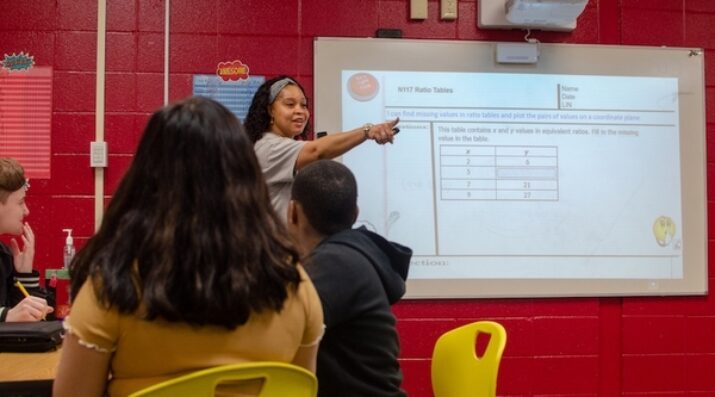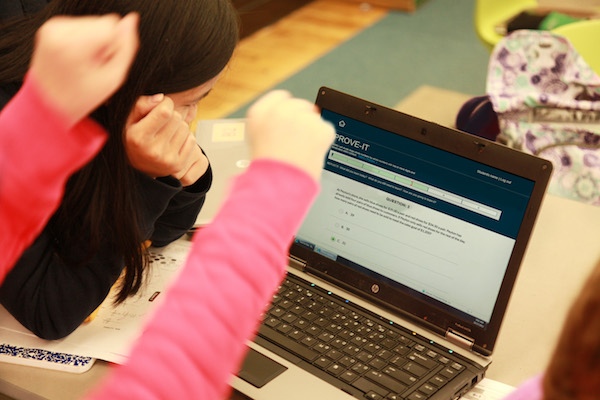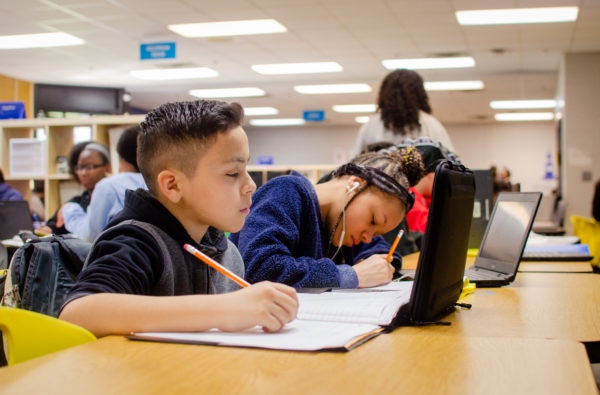Teachers Reflect on Using Technology in Personalized Learning
Topics

Educators often take advantage of educational technologies as they make the shifts in instruction, teacher roles, and learning experiences that next gen learning requires. Technology should not lead the design of learning, but when educators use it to personalize and enrich learning, it has the potential to accelerate mastery of critical content and skills by all students.
Educators new to personalized learning models like Teach to One: Math are at times surprised by the prominent role of the teacher and the variety of learning modalities taking place.
The words ‘personalized learning’ often bring up images of students on computers taught by virtual teachers and online assignments. But personalized learning means different things to different people, and there is a spectrum of solutions under this umbrella. At New Classrooms, we consider Teach to One: Math (TTO) at one end of the spectrum, providing a student-centered learning model rather than an off-the-shelf tech product or tool.
As a senior manager of site operations, I’ve been helping schools implement the TTO model for seven years. During that time, I’ve been met with occasional surprise by the prominent role of the teacher and the variety of learning modalities taking place. There is an inherent expectation to see smart boards and laptops in a modern classroom, but that shouldn’t translate to less face-time with educators.
To be clear, TTO could not exist without computers. Every day, students in the program take a short virtual assessment on a skill they worked on during math class. The result of that assessment dictates what they will see the following day. Instruction is differentiated on a day-to-day basis.

(Courtesy of New Classrooms)
I wanted to talk to some of our teachers about the role of technology and how it has shaped their work. Alexandra Brook, a teacher with Gray Elementary School in Chicago, has been working in TTO since its inception seven years ago. When I asked her about our daily scheduling process, she emphasized that technology—specifically, the daily scheduling algorithm—has actually made her more effective at her job. “I would not be able to provide this level of personalization or differentiation on my own in a traditional classroom setting,” she told me.
While technology plays a dominant role in the scheduling of the program, it takes a backseat to teachers when implemented on the ground. The program thrives because of the people in the classroom. Of the eight instructional modalities that comprise TTO, only three are computer-based or independent learning. The teacher’s role is no less important in any of them. In fact, we believe that effective facilitation of independent learning is perhaps the most challenging kind of teaching in the TTO learning model. The other modalities are made up of teacher-led instruction and collaborative learning.

(Courtesy of New Classrooms)
Visitors to TTO math centers see a mixture of these modalities at play. Some sections may have a teacher standing at the head of the class exploring math concepts through live investigations. Other areas may have groups of students (who have been assigned together based on their prior knowledge) to work collaboratively towards understanding a new skill. When working independently, students may watch and take notes on a virtual lesson, complete an online activity or educational game, or work in their notebook from a digital prompt. But it is the teachers in all of these sections who connect with the students and guide their learning.
Sam Martin, a teacher and math director at Learn 6 Charter School in Chicago, often gets asked about differences in planning between live instruction and independent learning. “One of the things I always emphasize is that having students who are working on an independent activity doesn’t mean less work for us. We need to prepare for obstacles that students may encounter working through those lessons on their own, and we always need to be proactive in our approach to instruction.”
Carrie Walsh, director of instructional support for TTO in Chicago, works in support of these efforts and believes “teachers have a crucial role in developing strong relationships with every student so that students feel safe and supported to take risks and advocate for themselves. In addition to being masters of content knowledge, teachers who excel at personalized learning make sure that their students understand themselves as learners and know the rationale for everything they do in the classroom (i.e., taking notes, collaborating with others, working through problems in multiple ways, etc.).”
These vital life-skills help students take ownership of their own learning. Students are held accountable because the pace of their learning is completely their own. They are exposed to the skills they need academically, and they are instructed and supported in this through the teachers who value their social and emotional well-being. This range of priorities, focusing on the needs of the whole student, is what sets personalized learning environments apart from a traditional model.
Even though it is a computer algorithm that groups students, delivers lesson assignments to teachers, and personalizes math instruction daily within Teach to One: Math, ‘personalized learning’ does not mean replacing a teacher with a computer in the program. The technology is simply a tool within the greater learning model, one that helps teachers differentiate their instruction. The real heart of a classroom hasn’t shifted much with this approach. At the end of the day, learning is still fueled by the connections between teachers and students, and no teaching tool could ever replace that bond.
This post originally appeared on the New Classrooms website. Photo at top courtesy of New Classrooms.




